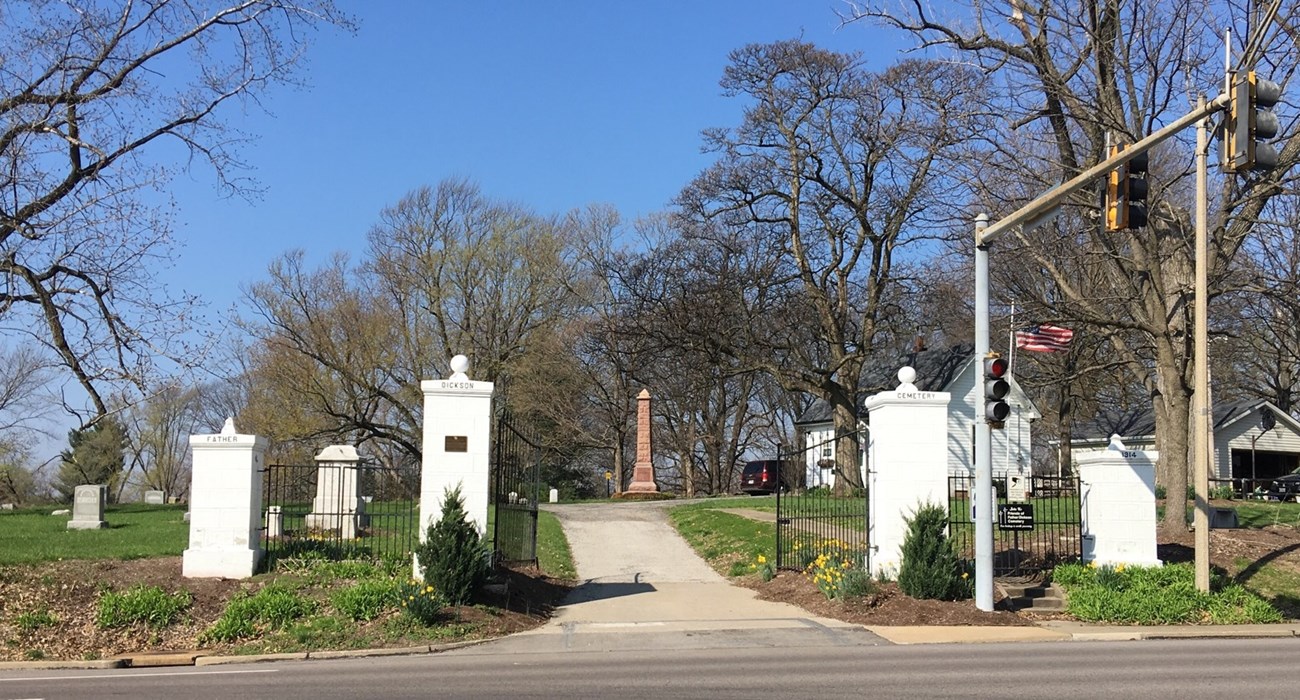Last updated: July 28, 2020
Article
African American History at Father Dickson Cemetery

Wikimedia Commons
The namesake of the cemetery, Moses “Father” Dickson, was born free in Ohio. He lived in Cincinnati for most of his youth and traveled through the South on steamboats, where he worked as a barber. During his travels through the slave states, Dickson was outraged at the treatment of enslaved people. He became radicalized while living St. Louis, and in 1846 he started the Knights of Liberty, a secret society dedicated to the overthrow of the slave system. Over the next ten years, Dickson and eleven other original members grew the Knights of Liberty a membership of over 42,000 enslaved and free Black men. They communicated in secret and met at night to drill and prepare for a coordinated uprising against slavery. Their oath of secrecy was absolute: “I can die, but will not reveal the name of any member until the slaves are free.” Dickson and other Knights of Liberty helped enslaved people escape through the Underground Railroad, and by 1857 a detailed plan was in the works for an organized insurrection. The original plan called for "a concentration of the forces…at Atlanta. We expected to have over 200,000 men by the time we reached Atlanta,” according to Dickson later in life. However, tensions between free and slave states were so high that Knights of Liberty leaders felt that a civil war was imminent, and that it was best to wait. When war finally came in 1861, many of the Knights, including Dickson, joined the Union Army. Following the war, Dickson was ordained as a pastor in the African Methodist Episcopal (AME) Church, and went on to be active in Freemasonry. In 1872, Dickson and his wife, Mary, reorganized the Knights of Liberty into the International Order of Twelve Knights and Daughters of Tabor, a fraternal organization which helped sick members, issued burial policies, and operated a hospital with an all-Black staff in Mound Bayou, Mississippi. Along with other Black Union veterans, Dickson helped organize and served on the Board of Directors of Lincoln Institute (now Lincoln University) in Jefferson City, MO. He was also instrumental in helping Black refugees from former slave states who passed through St. Louis (who became known as the Exodusters) to settle on homestead land in Kansas. Father Dickson passed away in St. Louis in 1901 and is buried at the cemetery which now bears his name.

Wikipedia
Other notable burials and memorials in Father Dickson cemetery include Mary Elisabeth “Mother” Dickson, Moses Dickson’s wife, and Susan Paul Smith Vashon, an educator, community organizer, and the namesake of Vashon High School in St. Louis. A large memorial sits in Father Dickson Cemetery to the African American cosmetics magnate Sarah Breedlove, better known as Madame C.J. Walker. Walker resided in St. Louis after marrying, and took a job selling cosmetics for local businesswoman Annie Malone. Walker soon developed her own products and was considered the wealthiest Black businesswoman in America at the time of her death. She is not buried at Father Dickson Cemetery, but is a widely admired figure throughout Black communities in the U.S. Recently, she was also the subject of the HBO mini-series Self-Made: Inspired by the Life of Madame C.J. Walker, starring Octavia Spencer.
Like many historic cemeteries, Father Dickson Cemetery was plagued by neglect and threatened with development throughout the years. However, this historic treasure is now cared for by a private group, the Friends of Father Dickson Cemetery, who have partnered with other community organizations to keep it beautiful and accessible for those who wish to visit and pay respects to the many individuals who are interred there. If you are interested in visiting or learning more about Father Dickson Cemetery, you are encouraged to reach out to the Friends of Father Dickson Cemetery at friendsoffather@aol.com. Ulysses S. Grant National Historic Site sells printed guidebooks for Father Dickson Cemetery in its bookstore, and the cemetery is the penultimate stop on the Bike Through History program, offered monthly by park staff.
